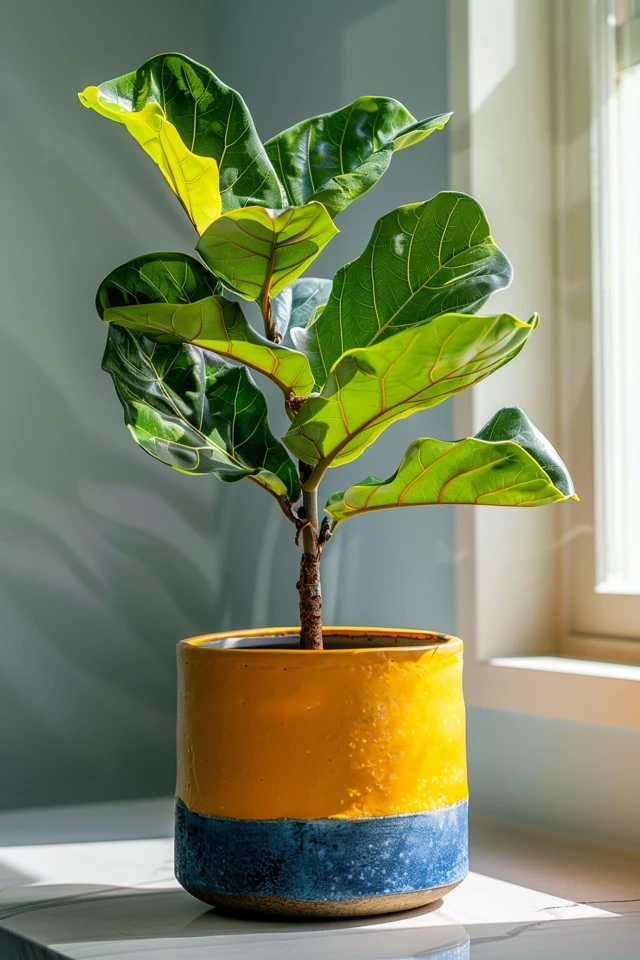Are you looking to transform your fiddle leaf fig into a stunning, branching tree? With the right techniques, you can achieve that lollipop shape with a slender trunk and a rounded crown of branches. Let me show you how to get your fiddle leaf fig to branch!
Pruning and notching are the key techniques to encourage branching in your fiddle leaf fig. Pruning disrupts the flow of the growth-regulating auxin hormone, leading to the development of lateral branches. Notching involves making a cut or wound on the trunk near a node, redirecting the plant’s energy to dormant leaf buds and resulting in new branch growth.
By implementing these methods, you can guide your fiddle leaf fig towards becoming a beautiful, branching tree. Say goodbye to that single stem and hello to a lush canopy of foliage!
Key Takeaways:
- Pruning and notching are effective techniques for encouraging branching in fiddle leaf fig trees.
- Pruning disrupts the flow of growth-regulating hormones and promotes the development of lateral branches.
- Notching redirects the plant’s energy to dormant leaf buds near nodes, stimulating new branch growth.
- Proper care, including adequate watering, nutrient-rich soil, and proper sunlight, is crucial for the health and branching of your fiddle leaf fig.
- Patience is key. Results may take time, so be consistent in your pruning and notching efforts.

Understanding Apical Dominance and Pruning Techniques
Apical dominance is a fascinating phenomenon observed in plants, where the main vertical stem of a plant grows more vigorously than the side stems. This growth pattern is a result of the plant’s survival instincts, directing its energy towards vertical growth to obtain maximum light for photosynthesis. But what can we do if we want to encourage branching in our fiddle leaf fig?
Enter pruning, or as some like to call it, “pinching.” Pruning involves carefully cutting or pinching the dominant vertical branch, disrupting the flow of the growth-regulating auxin hormone. By doing so, we can redirect the plant’s energy to the lower nodes, stimulating the development of lateral branches.
The severity of pruning has a direct effect on the resulting regrowth. Generally, the most vigorous shoot growth occurs within 6 to 8 inches of the pruning cut. To encourage branching, it’s important to make a precise cut just above a node, where a dormant leaf bud is waiting to spring into action.
But here’s a tip: try not to strip leaves off the trunk until new branches have established. The leaves provide nourishment for the developing branches and aid in their growth.
So, by understanding apical dominance and utilizing pruning techniques, we can guide the growth of our fiddle leaf fig and encourage the formation of beautiful branches.
Now that we’ve explored apical dominance and pruning, it’s time to discover another technique that can encourage branching in fiddle leaf fig trees: notching. Stay tuned for the next section!

Notching: A Technique for Branching Fiddle Leaf Fig Trees
Notching is an alternative technique to pruning for encouraging branching in fiddle leaf fig trees. It involves making a cut or incision above a node, disrupting the flow of growth-regulating hormones. This disruption directs the plant’s energy to dormant leaf buds near the node, leading to the growth of new branches.
Notching can be done using a clean, sharp blade and requires finesse to ensure the incision is deep enough to trigger the desired response without damaging the tree. This technique is particularly effective on fiddle leaf figs with thicker trunks, as they tend to have more dormant leaf buds.
While notching doesn’t guarantee success, it has a 30-50% chance of inducing branching, depending on the specific conditions of the tree. It’s important to choose the right spot for notching and to follow proper aftercare to maximize the chances of success.
To notch your fiddle leaf fig, follow these steps:
- Choose a spot on the trunk just above a node where you want to encourage branching.
- Using a clean and sharp blade, make a vertical cut or incision about 1/4 to 1/2 inch long.
- Be careful not to cut too deep and damage the tree. The incision should penetrate the bark but not reach the core of the trunk.
- After making the incision, leave it open. Avoid sealing or covering the wound, as this will interfere with the plant’s natural response.
- Monitor the notched area closely and provide the necessary care, such as proper watering, sunlight, and fertilization.
- Over time, you should start to see new buds forming near the notched area. These buds will eventually develop into branches.
Remember to exercise patience when using the notching technique, as it may take several weeks or even months for the branches to emerge. With consistent care and attention, you’ll be able to witness your fiddle leaf fig transform into a beautiful branching tree.

Conclusion
Encouraging branching in a fiddle leaf fig can be achieved through effective pruning and notching techniques. By disrupting apical dominance and redirecting the plant’s energy, these methods stimulate growth in lower nodes and dormant leaf buds, resulting in the development of beautiful, branching trees. However, success with these techniques requires patience and proper care.
In addition to pruning and notching, other factors play a crucial role in promoting branching. It is important to consider the thickness of the trunk, providing consistent watering and proper drainage, using nutrient-rich soil, and ensuring adequate sunlight for your fiddle leaf fig. These factors create favorable conditions for growth and increase the chances of successful branching.
Remember, transforming your fiddle leaf fig into a branching tree takes time and dedication. It is essential to monitor the health of your plant, adjusting its care regimen as needed. With the right techniques and attentive care, you can enjoy the beauty of a well-branched fiddle leaf fig in your home or garden.

